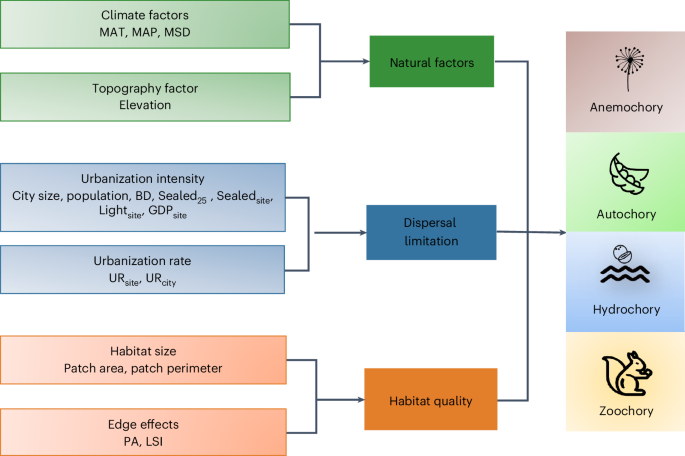
Response and sensitivity of urban plants with different seed dispersal modes
- Select a language for the TTS:
- UK English Female
- UK English Male
- US English Female
- US English Male
- Australian Female
- Australian Male
- Language selected: (auto detect) - EN
Play all audios:
Spontaneous plants, those not planted by people or remaining from before urbanization, are vital to urban biodiversity. Their distribution in urban systems is affected by seed dispersal mode
and environmental factors such as natural dispersal limitation and habitat quality factors. We assessed four seed dispersal modes in 16 cities in Yunnan province, the most biodiverse
province in China. Autochory, in which plants eject seeds or otherwise power their seeds’ dispersal, was the dominant seed dispersal mode of urban spontaneous plants in most cities (13 out
of 16), whereas hydrochory, or passive seed dispersal by water, was the least frequent. Our research showed spontaneous plants in urban ecosystems adopt convergent strategies to address
environmental stressors. The number of urban plants was significantly higher in colder and more-humid climates but decreased with increased dispersal limitations and reduced habitat quality.
Sensitivities to these factors varied, with autochory especially sensitive to dispersal limitation and hydrochory sensitive to habitat quality and climate. Findings suggest improving
habitat quality and creating green corridors would enhance conservation efforts for urban biodiversity.
The data and codes that support the findings of this study are publicly available via figshare at https://doi.org/10.6084/m9.figshare.27292317.v1 (ref. 67). Original photographs, collection
numbers and scanned images of the herbarium specimens created during our study (currently housed at Kunming Institute of Botany) can also be obtained from the corresponding author upon
request.
The code that supports the findings of this study is available via figshare at https://doi.org/10.6084/m9.figshare.27292317.v1 (ref. 67).
We thank X. Yu from Qiannan Normal University for Nationalities for helping with the species identification. This research was funded by Major Program for Basic Research Project of Yunnan
Province (L.D., 202101BC070002), the Ministry of Science and Technology of China (L.D., 2015FY210200), ECNU Academic Innovation Promotion Program for Excellent Doctoral Students (Z.G.,
YBNLTS2019), and the National Key Research and Development Program of China (Y.P., 2023YFF1305800). Y.P. acknowledges the funds from the Chinese Academy of Sciences (E429S10101) and the
Innovation Team Project of Northeast Institute of Geography and Agroecology, Chinese Academy of Sciences (2023CXTD03).
Global Institute for Urban and Regional Sustainability, Tiantong National Forest Ecosystem Observation and Research Station, School of Ecological and Environmental Sciences, East China
Normal University, Shanghai, China
Key Laboratory of Wetland Ecology and Environment, Northeast Institute of Geography and Agroecology, Chinese Academy of Sciences, Changchun, China
State Key Laboratory of Black Soils Conservation and Utilization, Northeast Institute of Geography and Agroecology, Chinese Academy of Sciences, Changchun, China
School of Landscape Architecture, Northeast Forestry University, Harbin, China
College of Agriculture and Life Sciences, Kunming University, Kunming, China
Institute of Science and Engineering of Ecology in Arid and Semi-arid Areas, Xi’an University of Architecture and Technology, Xi’an, China
Nelson Marlborough Institute of Technology, Nelson, New Zealand
Institute of Environmental Sciences, Leiden University, Leiden, the Netherlands
Z.G.: field survey, data collection, analysis, interpretation and drafting the manuscript; Y.Y., T.W., M.Z., T.X., Y.H.: field survey, collecting data and revising the manuscript; E.C., K.S.
and Y.P.: data analysis, interpretation of data, conception and revising the manuscript critically; K.S. and L.D.: funding, conception, revising the manuscript and final approval of the
manuscript. All authors have read and agreed to the published version of the manuscript.
Nature Cities thanks Ádám Lovas-Kiss, Rafael Zenni and the other, anonymous, reviewer(s) for their contribution to the peer review of this work.
Publisher’s note Springer Nature remains neutral with regard to jurisdictional claims in published maps and institutional affiliations.
Springer Nature or its licensor (e.g. a society or other partner) holds exclusive rights to this article under a publishing agreement with the author(s) or other rightsholder(s); author
self-archiving of the accepted manuscript version of this article is solely governed by the terms of such publishing agreement and applicable law.
Anyone you share the following link with will be able to read this content: